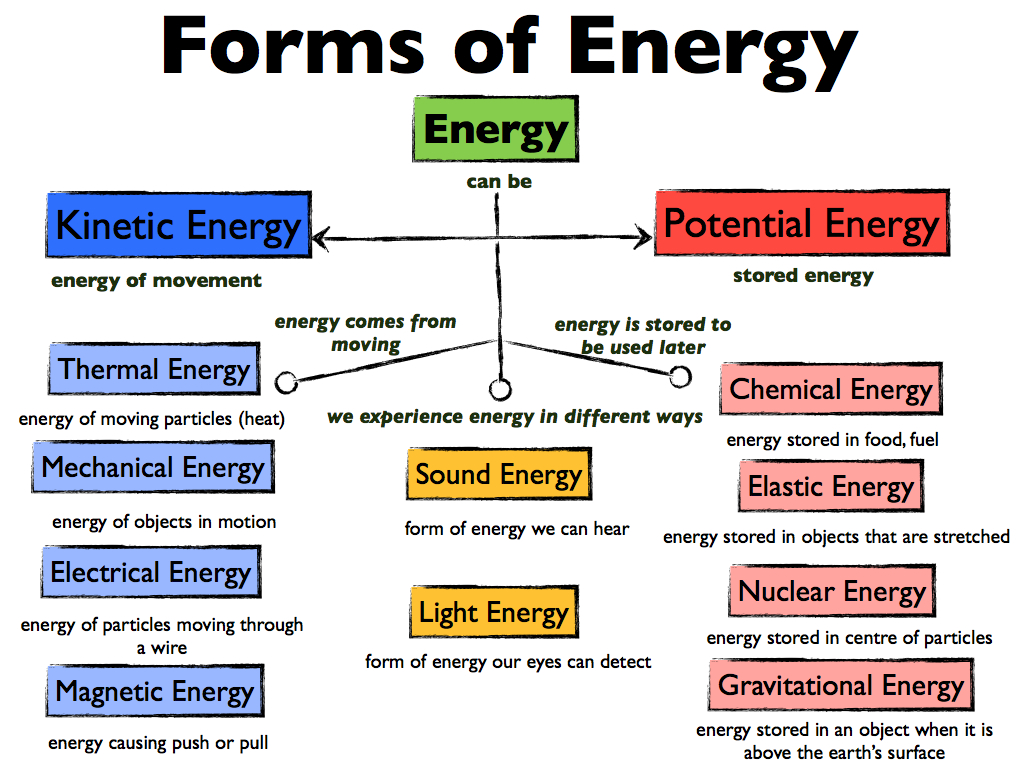"Why do we have use the term ATP in cells? Why can't we just call it energy?" - Pun
Energy... It's always there, but it can't be seen. It comes in many flavors; some easy to understand (temperature), some not so easy to understand (nuclear). It simply has the power to make change. Energy can change the position of a car, or change the brightness in a room or change how tired we are feeling on a Monday morning. Energy is a special thing that is completely different from matter. It simply exists. Sometimes it exists inside matter, like the energy that makes atoms vibrate super fast.
 |
| There are lots of different types of energy and ways they can interact with each other. |
One thing we definitely know is that we need energy. Our bodies need it to live. Our heart needs energy to push blood through our brain. Our lungs need energy to get oxygen to that blood. Our brain needs energy to help us remember the answer to that question on the test. All of that energy comes from food. Delicious, delicious food. Cakes, and sandwiches, and cookies, and potato chips and steaks and hamburgers and pizza... okay I'm getting carried away.
Food contains very important nutrients that we need to survive. When it comes to energy, we will focus on two of those nutrients: sugars and carbohydrates. Carbohydrates are just lots of sugar molecules all stuck together, so we can actually treat sugars and carbohydrates as the same things. When these sugars go into our cell, they get broken down and put back together many many times in three steps: glycolysis, the Kreb's cycle, and the electron transport chain. Let's have a quick look at what happens.
Sugar starts as C6H12O6 and through these three steps, carbons, hydrogens and waters go in and out like a black Friday market sale. The process is long and complicated and I'm sure you have or will memorize it sometime in the future because schools think that kind of thing is important.
 |
| I told you it was insane... |
The purpose of this cycle is to create molecules that are smaller, easier to move and contain a buttload of energy. What you can see in the diagram above is the production of those yellow star molecules, ATP and GTP. GTP is a little different in that it is energy specially designed for protein creation. But ATP is there and lots of it can be made. A single glucose molecule (tiny, simple sugar) can create 38 ATP molecules through glycolysis, the kreb's cycle and the electron transport chain.
ATP, Adenosine TriPhosphate, is a great molecule for energy. The Adenosine part is simply the hand that holds the energy. It's the phosphate groups (PO4 groups) that are the most important. Phosphates are great because they really like to leave molecules and move around. When they leave, the chemical energy packed in the bonds gets released, allowing the cells to move, twist, pull and shift in any way our body needs.
 |
| The ATP molecule, in all its glory. |
So why must we use ATP and not just "energy"? Well, it's because ATP is not energy. ATP is closer to a battery, with energy ready when you need it. Those 38 little ATP molecules will be on standby until you need to dodge a ball flying right at your face. The interesting thing is that your body makes ATP so fast, that it is actually always being used. The quote below should help you realize how much ATP our body truly uses.
 |
| Your 70kg body produces 180kg of ATP and then uses 180kg of ATP every day. That's a lot of energy. |
No comments:
Post a Comment